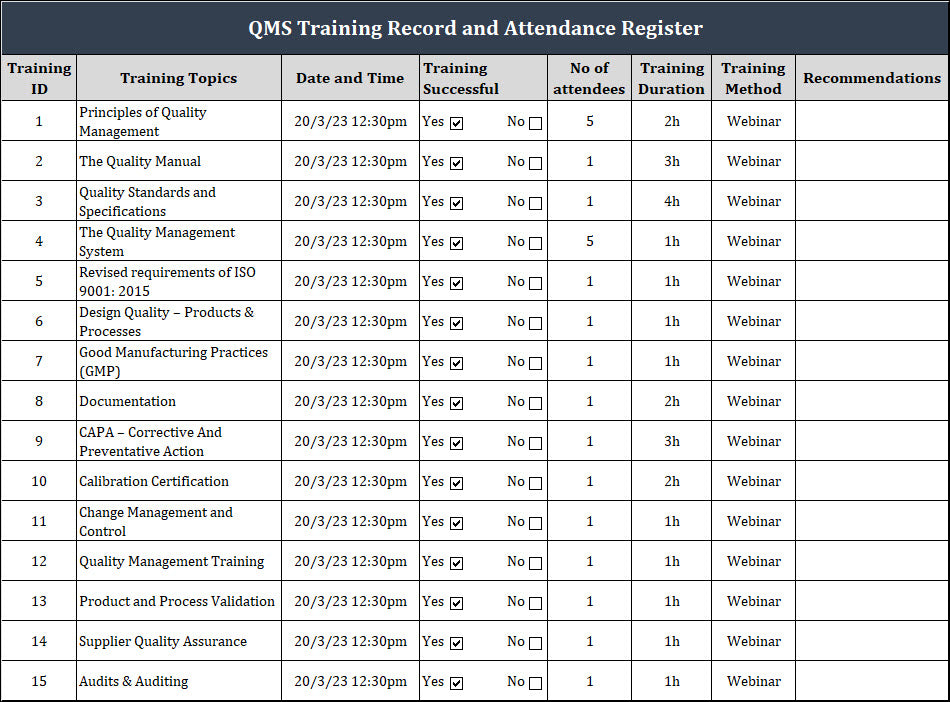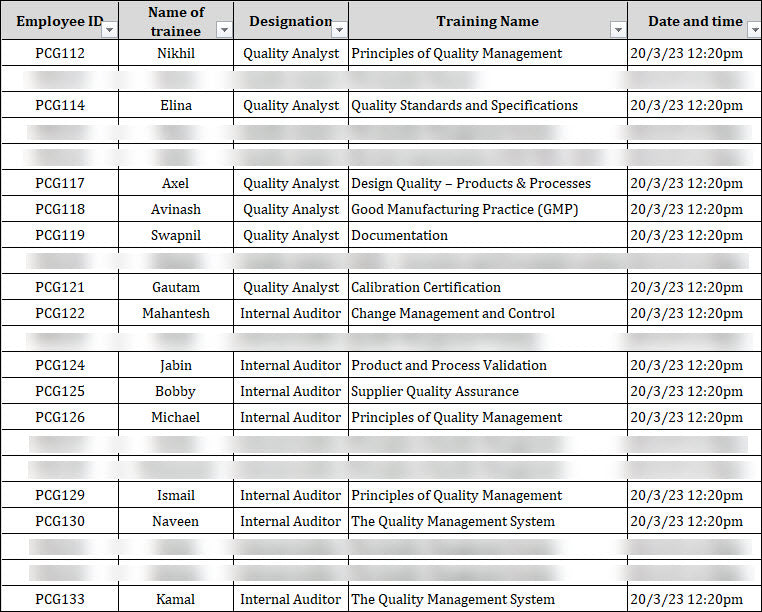ISO 9001 Training Record and Attendance Register Template
Maintaining a Training Record and Attendance Register is essential for businesses seeking ISO 9001 certification. This record demonstrates compliance with the ISO 9001 standard and ensures that employees receive the necessary training to perform their roles effectively. By accurately documenting training activities and attendance, organizations can improve operational efficiency, enhance employee development, and mitigate risks.

Understanding the Importance of Training Records and Attendance Registers in ISO 9001
Maintaining a comprehensive Training Record and Attendance Register is crucial for businesses seeking ISO 9001 certification. This record is tangible evidence of compliance with the ISO 9001 standard, showcasing a commitment to continuous improvement and employee development.
By accurately documenting training activities and attendance, organizations enhance operational efficiency by ensuring employees receive the necessary training to perform their roles effectively. This not only improves productivity but also mitigates risks associated with inadequate training.
Furthermore, a well-maintained record enables organizations to identify gaps in training, allowing them to promptly address any skills or knowledge deficiencies. Additionally, it facilitates tracking employee progress and identifying potential candidates for promotions or further developmental opportunities.
Benefits of Maintaining Comprehensive Training Records
Maintaining Comprehensive Training Records Brings Several Significant Benefits to Organizations Seeking ISO 9001 certification. Firstly, it allows businesses to demonstrate their commitment to compliance with the ISO 9001 standard. Organizations can showcase their dedication to continuous improvement and employee development by having tangible evidence of training activities and attendance.
Secondly, keeping accurate training records enhances operational efficiency. When employees receive the necessary training to perform their roles effectively, productivity improves, and risks associated with inadequate training are mitigated. This can lead to higher quality products or services and increased customer satisfaction.
Additionally, a well-maintained training record enables organizations to identify gaps in training promptly. By doing so, they can take swift action to address any knowledge or skill deficiencies, ensuring that employees have the necessary competencies to excel in their roles.
Furthermore, a comprehensive training record allows organizations to track employee progress and identify potential candidates for promotions or further developmental opportunities. Organizations can foster a culture of continuous learning and improvement by recognizing employees' achievements and providing them with ongoing training and development.

Addressing Common Challenges in Managing Training Records and Attendance Registers
- While maintaining comprehensive training records and attendance registers is essential, organizations often face challenges in effectively managing these documents. One of the primary obstacles is the sheer volume of information to be recorded and organized. With numerous employees attending various training sessions, it can be overwhelming to track all the details accurately.
- Another challenge is ensuring the accuracy and completeness of the records. Human error, miscommunication, or outdated systems can result in missing or incorrect information, which can hinder the overall effectiveness of the training program.
- Furthermore, organizations may encounter difficulties in standardizing the format and content of the records. With different trainers and training programs, inconsistencies may arise in documenting the necessary details, making it challenging to analyze and report on the training progress and outcomes effectively.
- Organizations should consider implementing a robust training management system or software to address these challenges. Such tools can automate the recording and organizing of training records, ensuring accuracy and completeness. Additionally, establishing standardized templates and guidelines for recording training information can help maintain consistency across the organization.
- Regular audits and reviews of the training records and attendance registers are crucial to identifying and resolving any discrepancies or gaps. These activities will help organizations maintain the integrity of the training data and ensure compliance with ISO 9001 standards.
Conclusion
In conclusion, effectively managing training records and attendance registers is vital for organizations striving to comply with ISO 9001 standards. While challenges may arise, such as the overwhelming volume of information, the potential for errors, and formatting inconsistencies, solutions are available.
Implementing a robust training management system or software can automate the recording and organization of training records, ensuring accuracy and completeness. Standardizing templates and guidelines for recording training information can also help maintain consistency across the organization.

